Strategic Leadership Analysis: Barclays PLC and Sector Changes
VerifiedAdded on 2023/01/12
|16
|5759
|53
Report
AI Summary
This report provides a comprehensive analysis of strategic leadership within Barclays PLC, examining its role in managing and delivering change, particularly in the context of the banking and finance sector. It delves into the importance of leadership in organizational change, exploring various leadership styles and models, including Kotter's 8-step model and Porter's diamond model, in response to key changes such as globalization, internationalization, and technological innovation. The report assesses the capabilities and strategies of key business leaders, and evaluates the use of performance metrics for successful change implementation. The analysis highlights the practical application of leadership theories within Barclays PLC, discussing both the strengths and limitations of the models, providing valuable insights into effective change management strategies in the banking sector.
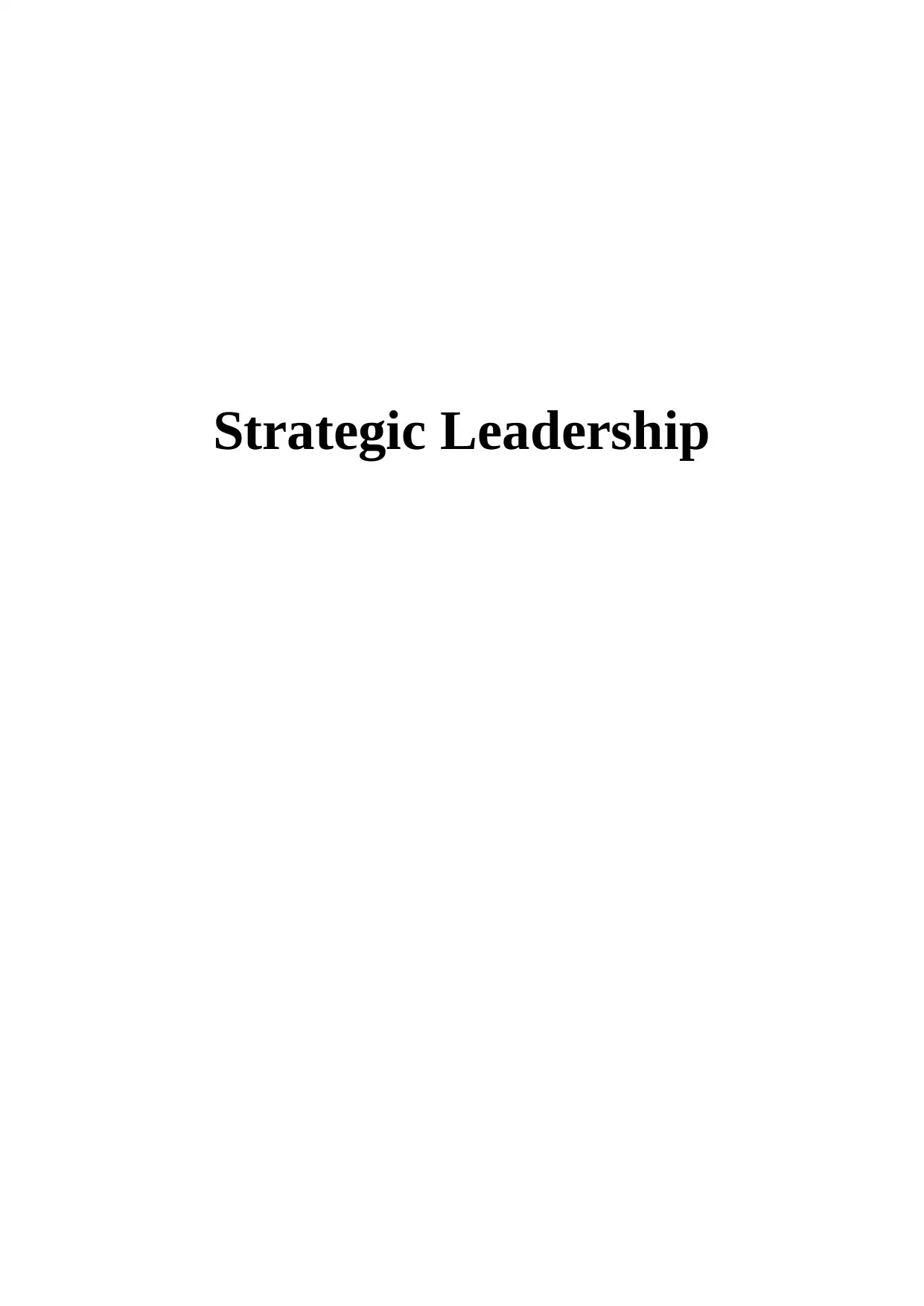
Strategic Leadership
Paraphrase This Document
Need a fresh take? Get an instant paraphrase of this document with our AI Paraphraser
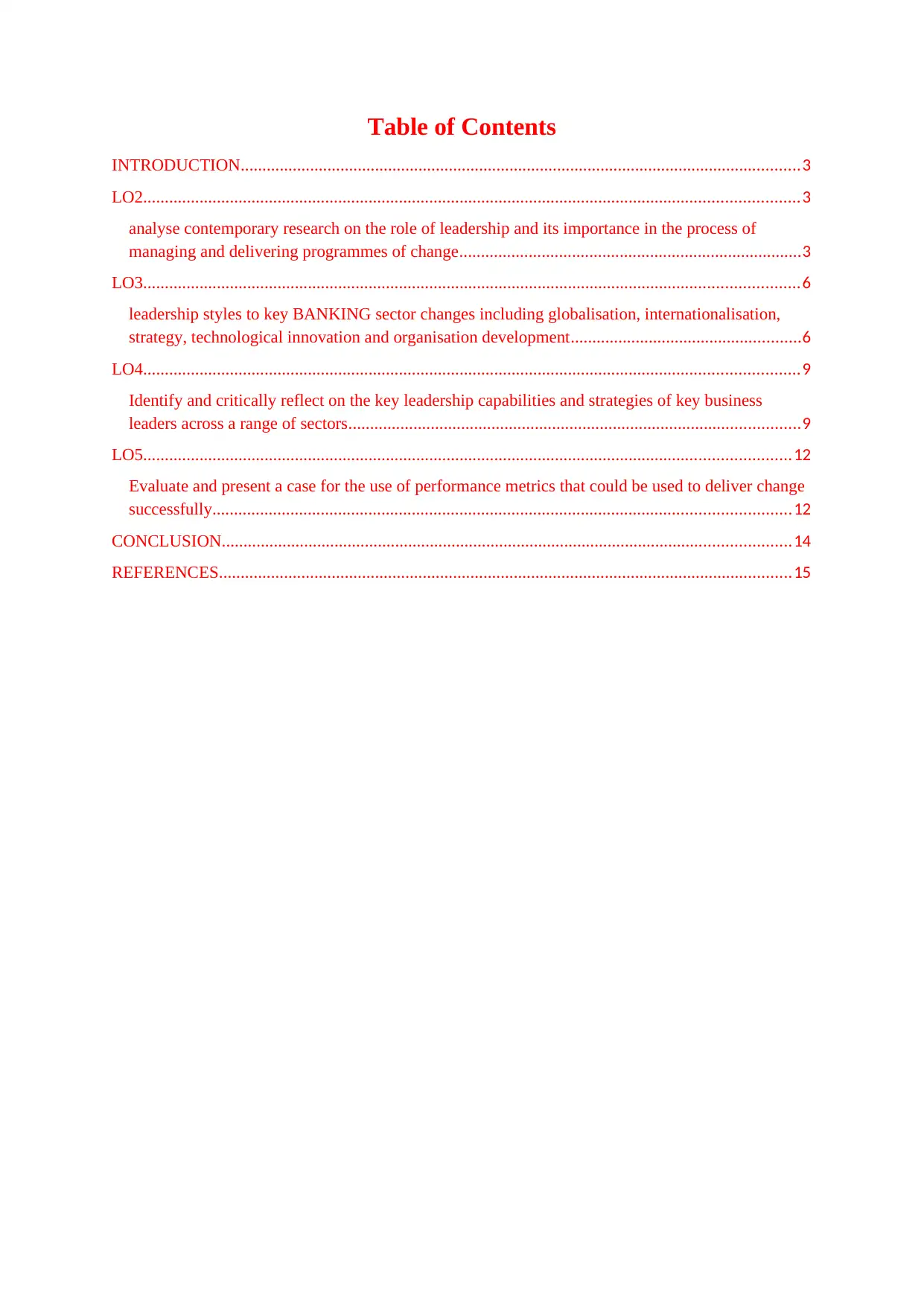
Table of Contents
INTRODUCTION.................................................................................................................................3
LO2.......................................................................................................................................................3
analyse contemporary research on the role of leadership and its importance in the process of
managing and delivering programmes of change...............................................................................3
LO3.......................................................................................................................................................6
leadership styles to key BANKING sector changes including globalisation, internationalisation,
strategy, technological innovation and organisation development.....................................................6
LO4.......................................................................................................................................................9
Identify and critically reflect on the key leadership capabilities and strategies of key business
leaders across a range of sectors........................................................................................................9
LO5.....................................................................................................................................................12
Evaluate and present a case for the use of performance metrics that could be used to deliver change
successfully.....................................................................................................................................12
CONCLUSION...................................................................................................................................14
REFERENCES....................................................................................................................................15
INTRODUCTION.................................................................................................................................3
LO2.......................................................................................................................................................3
analyse contemporary research on the role of leadership and its importance in the process of
managing and delivering programmes of change...............................................................................3
LO3.......................................................................................................................................................6
leadership styles to key BANKING sector changes including globalisation, internationalisation,
strategy, technological innovation and organisation development.....................................................6
LO4.......................................................................................................................................................9
Identify and critically reflect on the key leadership capabilities and strategies of key business
leaders across a range of sectors........................................................................................................9
LO5.....................................................................................................................................................12
Evaluate and present a case for the use of performance metrics that could be used to deliver change
successfully.....................................................................................................................................12
CONCLUSION...................................................................................................................................14
REFERENCES....................................................................................................................................15
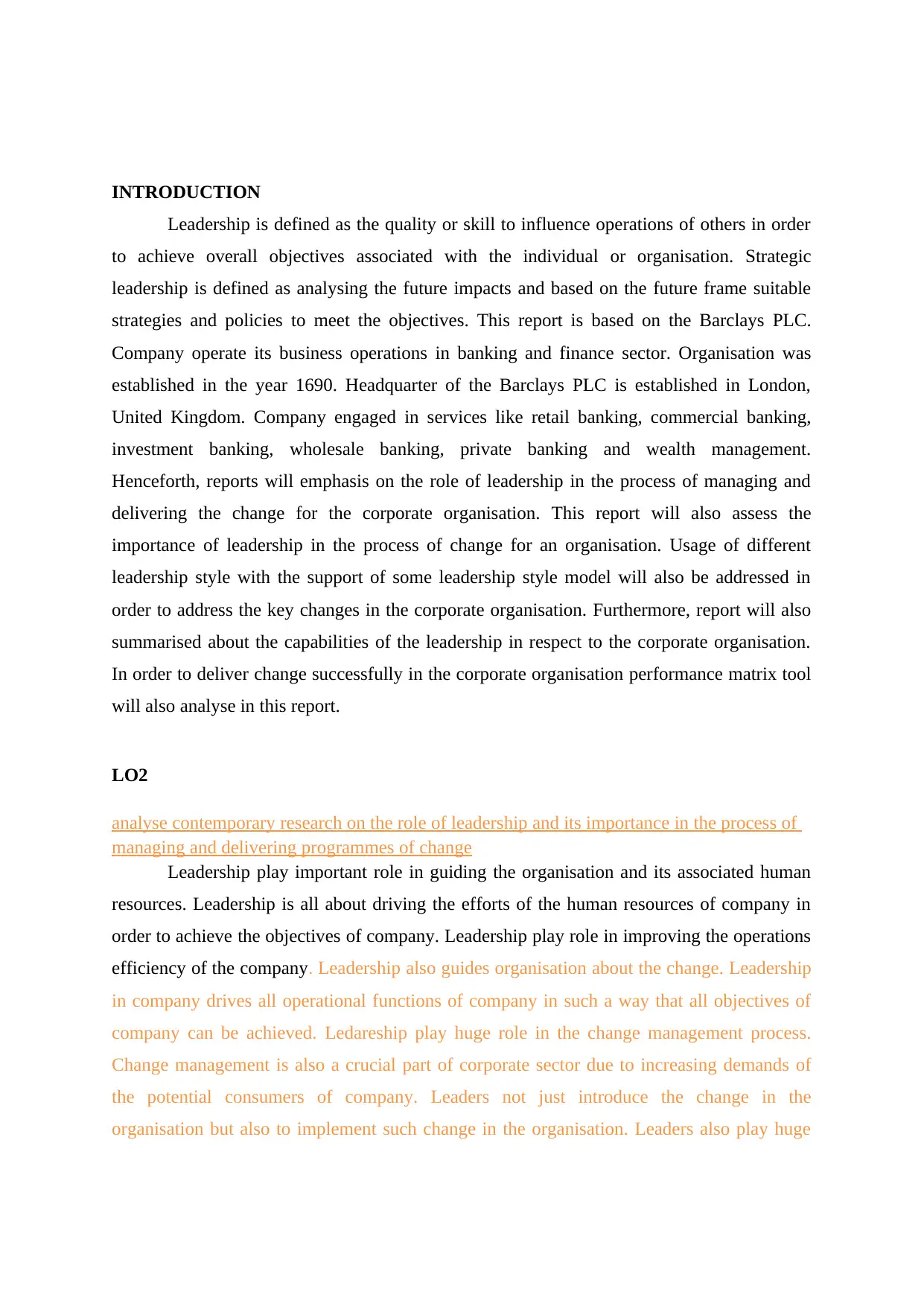
INTRODUCTION
Leadership is defined as the quality or skill to influence operations of others in order
to achieve overall objectives associated with the individual or organisation. Strategic
leadership is defined as analysing the future impacts and based on the future frame suitable
strategies and policies to meet the objectives. This report is based on the Barclays PLC.
Company operate its business operations in banking and finance sector. Organisation was
established in the year 1690. Headquarter of the Barclays PLC is established in London,
United Kingdom. Company engaged in services like retail banking, commercial banking,
investment banking, wholesale banking, private banking and wealth management.
Henceforth, reports will emphasis on the role of leadership in the process of managing and
delivering the change for the corporate organisation. This report will also assess the
importance of leadership in the process of change for an organisation. Usage of different
leadership style with the support of some leadership style model will also be addressed in
order to address the key changes in the corporate organisation. Furthermore, report will also
summarised about the capabilities of the leadership in respect to the corporate organisation.
In order to deliver change successfully in the corporate organisation performance matrix tool
will also analyse in this report.
LO2
analyse contemporary research on the role of leadership and its importance in the process of
managing and delivering programmes of change
Leadership play important role in guiding the organisation and its associated human
resources. Leadership is all about driving the efforts of the human resources of company in
order to achieve the objectives of company. Leadership play role in improving the operations
efficiency of the company. Leadership also guides organisation about the change. Leadership
in company drives all operational functions of company in such a way that all objectives of
company can be achieved. Ledareship play huge role in the change management process.
Change management is also a crucial part of corporate sector due to increasing demands of
the potential consumers of company. Leaders not just introduce the change in the
organisation but also to implement such change in the organisation. Leaders also play huge
Leadership is defined as the quality or skill to influence operations of others in order
to achieve overall objectives associated with the individual or organisation. Strategic
leadership is defined as analysing the future impacts and based on the future frame suitable
strategies and policies to meet the objectives. This report is based on the Barclays PLC.
Company operate its business operations in banking and finance sector. Organisation was
established in the year 1690. Headquarter of the Barclays PLC is established in London,
United Kingdom. Company engaged in services like retail banking, commercial banking,
investment banking, wholesale banking, private banking and wealth management.
Henceforth, reports will emphasis on the role of leadership in the process of managing and
delivering the change for the corporate organisation. This report will also assess the
importance of leadership in the process of change for an organisation. Usage of different
leadership style with the support of some leadership style model will also be addressed in
order to address the key changes in the corporate organisation. Furthermore, report will also
summarised about the capabilities of the leadership in respect to the corporate organisation.
In order to deliver change successfully in the corporate organisation performance matrix tool
will also analyse in this report.
LO2
analyse contemporary research on the role of leadership and its importance in the process of
managing and delivering programmes of change
Leadership play important role in guiding the organisation and its associated human
resources. Leadership is all about driving the efforts of the human resources of company in
order to achieve the objectives of company. Leadership play role in improving the operations
efficiency of the company. Leadership also guides organisation about the change. Leadership
in company drives all operational functions of company in such a way that all objectives of
company can be achieved. Ledareship play huge role in the change management process.
Change management is also a crucial part of corporate sector due to increasing demands of
the potential consumers of company. Leaders not just introduce the change in the
organisation but also to implement such change in the organisation. Leaders also play huge
⊘ This is a preview!⊘
Do you want full access?
Subscribe today to unlock all pages.

Trusted by 1+ million students worldwide
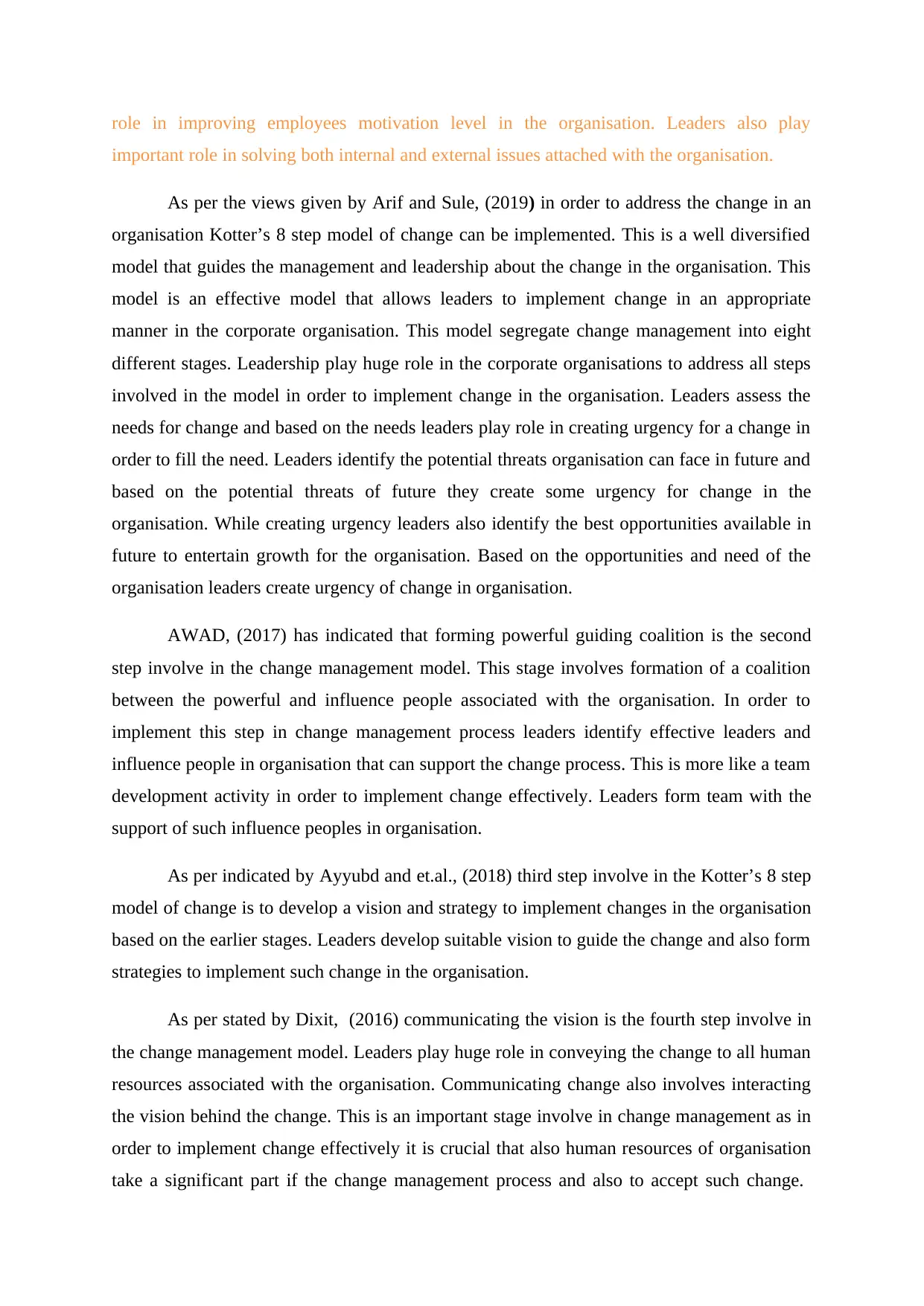
role in improving employees motivation level in the organisation. Leaders also play
important role in solving both internal and external issues attached with the organisation.
As per the views given by Arif and Sule, (2019) in order to address the change in an
organisation Kotter’s 8 step model of change can be implemented. This is a well diversified
model that guides the management and leadership about the change in the organisation. This
model is an effective model that allows leaders to implement change in an appropriate
manner in the corporate organisation. This model segregate change management into eight
different stages. Leadership play huge role in the corporate organisations to address all steps
involved in the model in order to implement change in the organisation. Leaders assess the
needs for change and based on the needs leaders play role in creating urgency for a change in
order to fill the need. Leaders identify the potential threats organisation can face in future and
based on the potential threats of future they create some urgency for change in the
organisation. While creating urgency leaders also identify the best opportunities available in
future to entertain growth for the organisation. Based on the opportunities and need of the
organisation leaders create urgency of change in organisation.
AWAD, (2017) has indicated that forming powerful guiding coalition is the second
step involve in the change management model. This stage involves formation of a coalition
between the powerful and influence people associated with the organisation. In order to
implement this step in change management process leaders identify effective leaders and
influence people in organisation that can support the change process. This is more like a team
development activity in order to implement change effectively. Leaders form team with the
support of such influence peoples in organisation.
As per indicated by Ayyubd and et.al., (2018) third step involve in the Kotter’s 8 step
model of change is to develop a vision and strategy to implement changes in the organisation
based on the earlier stages. Leaders develop suitable vision to guide the change and also form
strategies to implement such change in the organisation.
As per stated by Dixit, (2016) communicating the vision is the fourth step involve in
the change management model. Leaders play huge role in conveying the change to all human
resources associated with the organisation. Communicating change also involves interacting
the vision behind the change. This is an important stage involve in change management as in
order to implement change effectively it is crucial that also human resources of organisation
take a significant part if the change management process and also to accept such change.
important role in solving both internal and external issues attached with the organisation.
As per the views given by Arif and Sule, (2019) in order to address the change in an
organisation Kotter’s 8 step model of change can be implemented. This is a well diversified
model that guides the management and leadership about the change in the organisation. This
model is an effective model that allows leaders to implement change in an appropriate
manner in the corporate organisation. This model segregate change management into eight
different stages. Leadership play huge role in the corporate organisations to address all steps
involved in the model in order to implement change in the organisation. Leaders assess the
needs for change and based on the needs leaders play role in creating urgency for a change in
order to fill the need. Leaders identify the potential threats organisation can face in future and
based on the potential threats of future they create some urgency for change in the
organisation. While creating urgency leaders also identify the best opportunities available in
future to entertain growth for the organisation. Based on the opportunities and need of the
organisation leaders create urgency of change in organisation.
AWAD, (2017) has indicated that forming powerful guiding coalition is the second
step involve in the change management model. This stage involves formation of a coalition
between the powerful and influence people associated with the organisation. In order to
implement this step in change management process leaders identify effective leaders and
influence people in organisation that can support the change process. This is more like a team
development activity in order to implement change effectively. Leaders form team with the
support of such influence peoples in organisation.
As per indicated by Ayyubd and et.al., (2018) third step involve in the Kotter’s 8 step
model of change is to develop a vision and strategy to implement changes in the organisation
based on the earlier stages. Leaders develop suitable vision to guide the change and also form
strategies to implement such change in the organisation.
As per stated by Dixit, (2016) communicating the vision is the fourth step involve in
the change management model. Leaders play huge role in conveying the change to all human
resources associated with the organisation. Communicating change also involves interacting
the vision behind the change. This is an important stage involve in change management as in
order to implement change effectively it is crucial that also human resources of organisation
take a significant part if the change management process and also to accept such change.
Paraphrase This Document
Need a fresh take? Get an instant paraphrase of this document with our AI Paraphraser
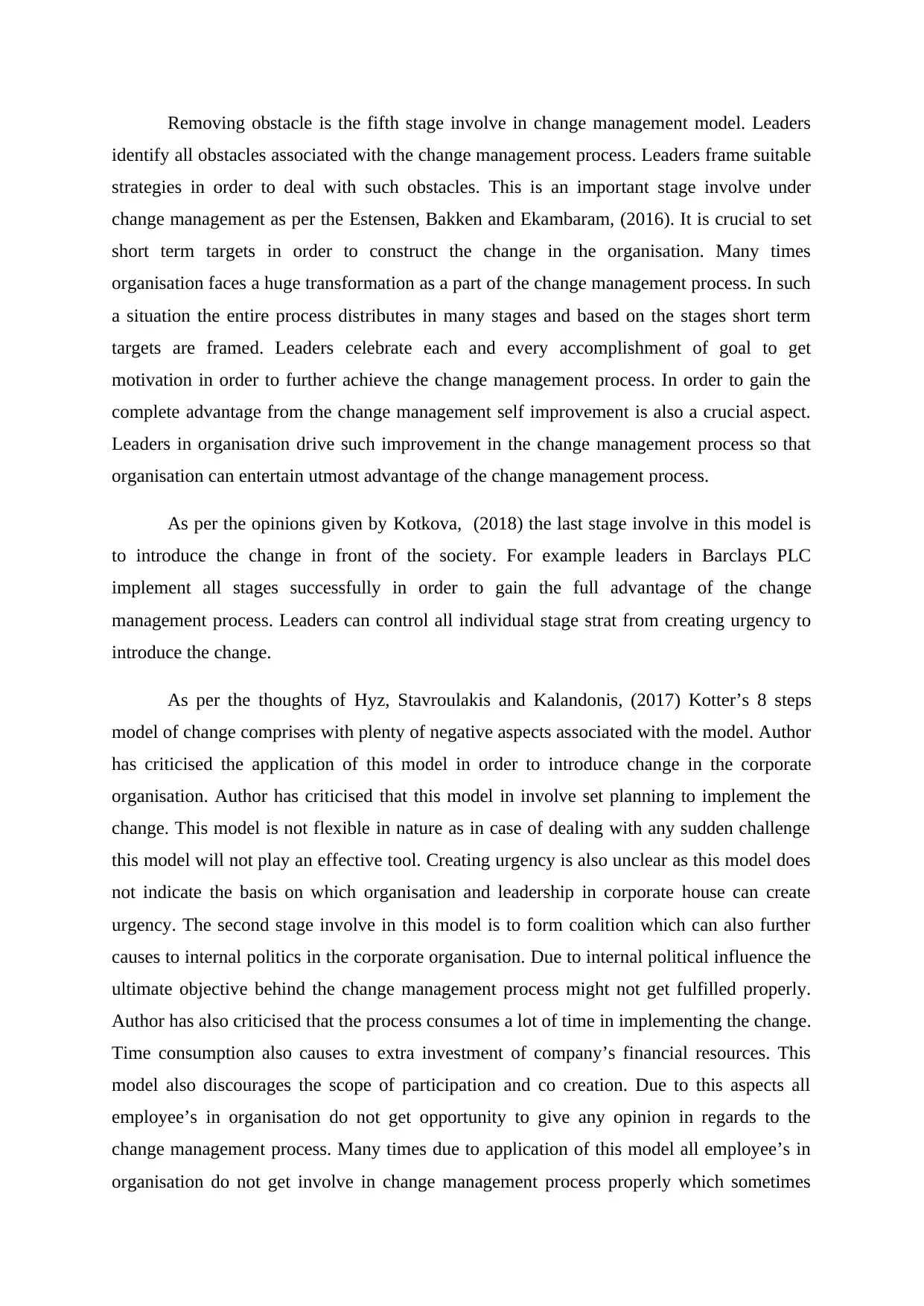
Removing obstacle is the fifth stage involve in change management model. Leaders
identify all obstacles associated with the change management process. Leaders frame suitable
strategies in order to deal with such obstacles. This is an important stage involve under
change management as per the Estensen, Bakken and Ekambaram, (2016). It is crucial to set
short term targets in order to construct the change in the organisation. Many times
organisation faces a huge transformation as a part of the change management process. In such
a situation the entire process distributes in many stages and based on the stages short term
targets are framed. Leaders celebrate each and every accomplishment of goal to get
motivation in order to further achieve the change management process. In order to gain the
complete advantage from the change management self improvement is also a crucial aspect.
Leaders in organisation drive such improvement in the change management process so that
organisation can entertain utmost advantage of the change management process.
As per the opinions given by Kotkova, (2018) the last stage involve in this model is
to introduce the change in front of the society. For example leaders in Barclays PLC
implement all stages successfully in order to gain the full advantage of the change
management process. Leaders can control all individual stage strat from creating urgency to
introduce the change.
As per the thoughts of Hyz, Stavroulakis and Kalandonis, (2017) Kotter’s 8 steps
model of change comprises with plenty of negative aspects associated with the model. Author
has criticised the application of this model in order to introduce change in the corporate
organisation. Author has criticised that this model in involve set planning to implement the
change. This model is not flexible in nature as in case of dealing with any sudden challenge
this model will not play an effective tool. Creating urgency is also unclear as this model does
not indicate the basis on which organisation and leadership in corporate house can create
urgency. The second stage involve in this model is to form coalition which can also further
causes to internal politics in the corporate organisation. Due to internal political influence the
ultimate objective behind the change management process might not get fulfilled properly.
Author has also criticised that the process consumes a lot of time in implementing the change.
Time consumption also causes to extra investment of company’s financial resources. This
model also discourages the scope of participation and co creation. Due to this aspects all
employee’s in organisation do not get opportunity to give any opinion in regards to the
change management process. Many times due to application of this model all employee’s in
organisation do not get involve in change management process properly which sometimes
identify all obstacles associated with the change management process. Leaders frame suitable
strategies in order to deal with such obstacles. This is an important stage involve under
change management as per the Estensen, Bakken and Ekambaram, (2016). It is crucial to set
short term targets in order to construct the change in the organisation. Many times
organisation faces a huge transformation as a part of the change management process. In such
a situation the entire process distributes in many stages and based on the stages short term
targets are framed. Leaders celebrate each and every accomplishment of goal to get
motivation in order to further achieve the change management process. In order to gain the
complete advantage from the change management self improvement is also a crucial aspect.
Leaders in organisation drive such improvement in the change management process so that
organisation can entertain utmost advantage of the change management process.
As per the opinions given by Kotkova, (2018) the last stage involve in this model is
to introduce the change in front of the society. For example leaders in Barclays PLC
implement all stages successfully in order to gain the full advantage of the change
management process. Leaders can control all individual stage strat from creating urgency to
introduce the change.
As per the thoughts of Hyz, Stavroulakis and Kalandonis, (2017) Kotter’s 8 steps
model of change comprises with plenty of negative aspects associated with the model. Author
has criticised the application of this model in order to introduce change in the corporate
organisation. Author has criticised that this model in involve set planning to implement the
change. This model is not flexible in nature as in case of dealing with any sudden challenge
this model will not play an effective tool. Creating urgency is also unclear as this model does
not indicate the basis on which organisation and leadership in corporate house can create
urgency. The second stage involve in this model is to form coalition which can also further
causes to internal politics in the corporate organisation. Due to internal political influence the
ultimate objective behind the change management process might not get fulfilled properly.
Author has also criticised that the process consumes a lot of time in implementing the change.
Time consumption also causes to extra investment of company’s financial resources. This
model also discourages the scope of participation and co creation. Due to this aspects all
employee’s in organisation do not get opportunity to give any opinion in regards to the
change management process. Many times due to application of this model all employee’s in
organisation do not get involve in change management process properly which sometimes
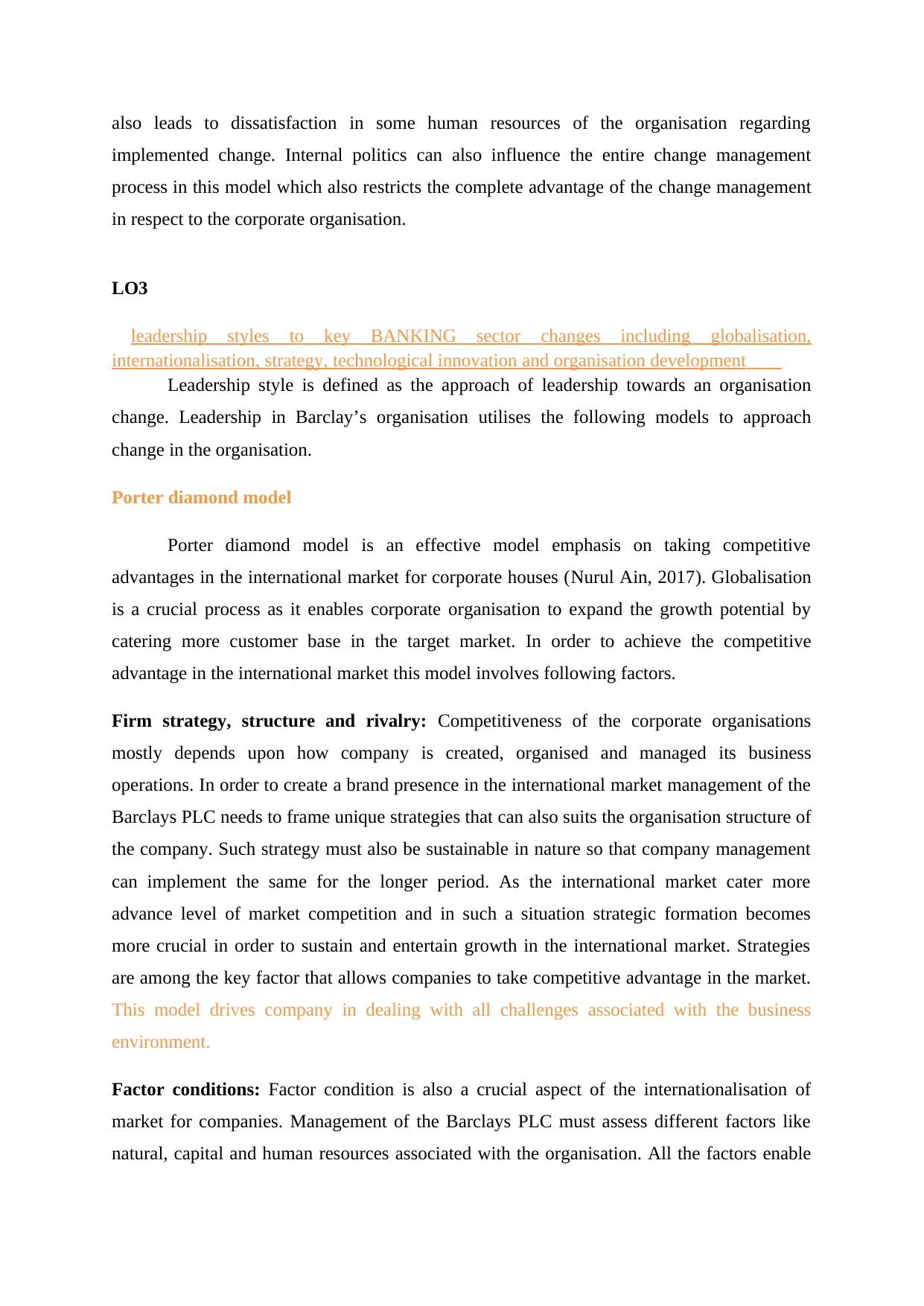
also leads to dissatisfaction in some human resources of the organisation regarding
implemented change. Internal politics can also influence the entire change management
process in this model which also restricts the complete advantage of the change management
in respect to the corporate organisation.
LO3
leadership styles to key BANKING sector changes including globalisation,
internationalisation, strategy, technological innovation and organisation development
Leadership style is defined as the approach of leadership towards an organisation
change. Leadership in Barclay’s organisation utilises the following models to approach
change in the organisation.
Porter diamond model
Porter diamond model is an effective model emphasis on taking competitive
advantages in the international market for corporate houses (Nurul Ain, 2017). Globalisation
is a crucial process as it enables corporate organisation to expand the growth potential by
catering more customer base in the target market. In order to achieve the competitive
advantage in the international market this model involves following factors.
Firm strategy, structure and rivalry: Competitiveness of the corporate organisations
mostly depends upon how company is created, organised and managed its business
operations. In order to create a brand presence in the international market management of the
Barclays PLC needs to frame unique strategies that can also suits the organisation structure of
the company. Such strategy must also be sustainable in nature so that company management
can implement the same for the longer period. As the international market cater more
advance level of market competition and in such a situation strategic formation becomes
more crucial in order to sustain and entertain growth in the international market. Strategies
are among the key factor that allows companies to take competitive advantage in the market.
This model drives company in dealing with all challenges associated with the business
environment.
Factor conditions: Factor condition is also a crucial aspect of the internationalisation of
market for companies. Management of the Barclays PLC must assess different factors like
natural, capital and human resources associated with the organisation. All the factors enable
implemented change. Internal politics can also influence the entire change management
process in this model which also restricts the complete advantage of the change management
in respect to the corporate organisation.
LO3
leadership styles to key BANKING sector changes including globalisation,
internationalisation, strategy, technological innovation and organisation development
Leadership style is defined as the approach of leadership towards an organisation
change. Leadership in Barclay’s organisation utilises the following models to approach
change in the organisation.
Porter diamond model
Porter diamond model is an effective model emphasis on taking competitive
advantages in the international market for corporate houses (Nurul Ain, 2017). Globalisation
is a crucial process as it enables corporate organisation to expand the growth potential by
catering more customer base in the target market. In order to achieve the competitive
advantage in the international market this model involves following factors.
Firm strategy, structure and rivalry: Competitiveness of the corporate organisations
mostly depends upon how company is created, organised and managed its business
operations. In order to create a brand presence in the international market management of the
Barclays PLC needs to frame unique strategies that can also suits the organisation structure of
the company. Such strategy must also be sustainable in nature so that company management
can implement the same for the longer period. As the international market cater more
advance level of market competition and in such a situation strategic formation becomes
more crucial in order to sustain and entertain growth in the international market. Strategies
are among the key factor that allows companies to take competitive advantage in the market.
This model drives company in dealing with all challenges associated with the business
environment.
Factor conditions: Factor condition is also a crucial aspect of the internationalisation of
market for companies. Management of the Barclays PLC must assess different factors like
natural, capital and human resources associated with the organisation. All the factors enable
⊘ This is a preview!⊘
Do you want full access?
Subscribe today to unlock all pages.

Trusted by 1+ million students worldwide
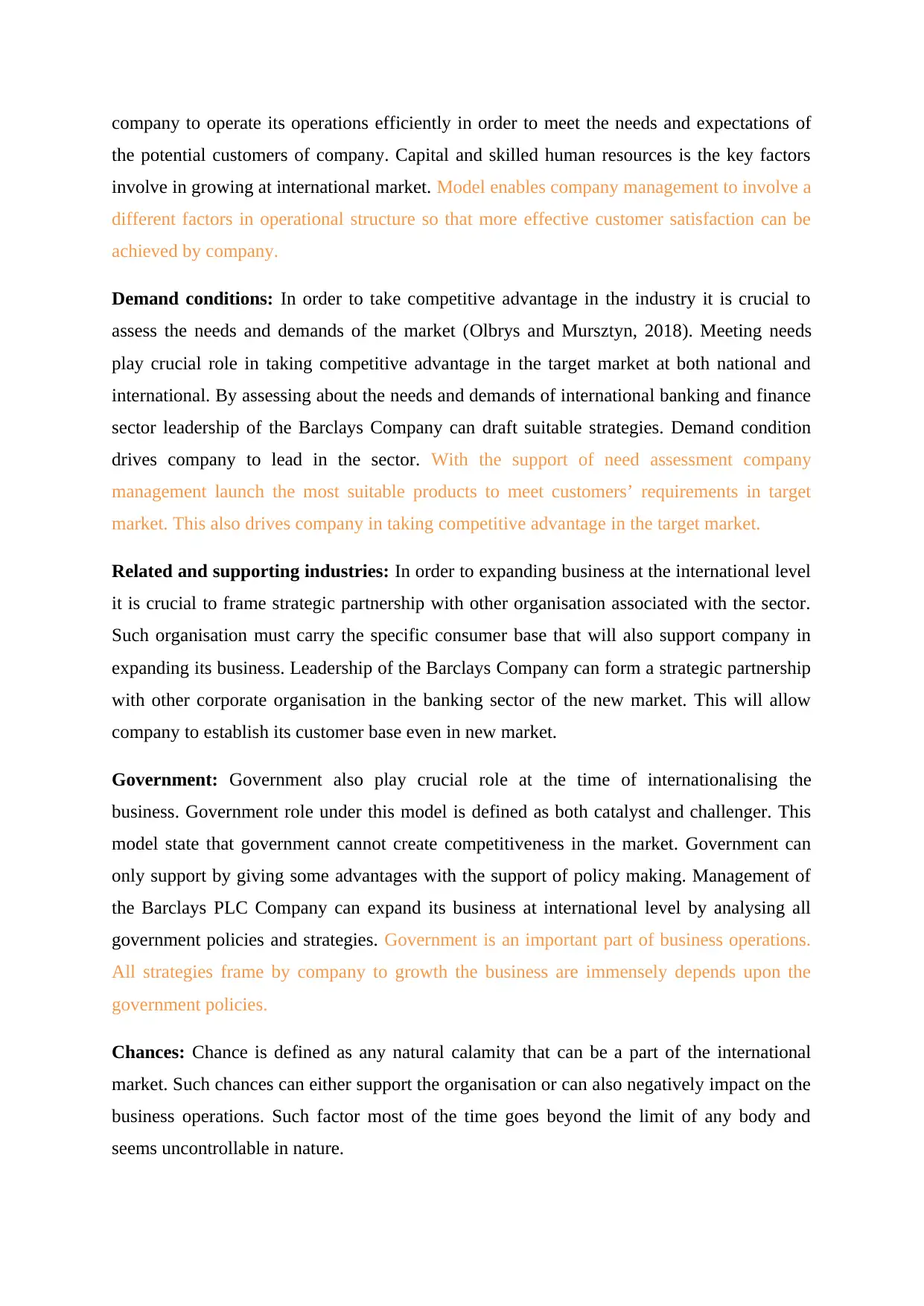
company to operate its operations efficiently in order to meet the needs and expectations of
the potential customers of company. Capital and skilled human resources is the key factors
involve in growing at international market. Model enables company management to involve a
different factors in operational structure so that more effective customer satisfaction can be
achieved by company.
Demand conditions: In order to take competitive advantage in the industry it is crucial to
assess the needs and demands of the market (Olbrys and Mursztyn, 2018). Meeting needs
play crucial role in taking competitive advantage in the target market at both national and
international. By assessing about the needs and demands of international banking and finance
sector leadership of the Barclays Company can draft suitable strategies. Demand condition
drives company to lead in the sector. With the support of need assessment company
management launch the most suitable products to meet customers’ requirements in target
market. This also drives company in taking competitive advantage in the target market.
Related and supporting industries: In order to expanding business at the international level
it is crucial to frame strategic partnership with other organisation associated with the sector.
Such organisation must carry the specific consumer base that will also support company in
expanding its business. Leadership of the Barclays Company can form a strategic partnership
with other corporate organisation in the banking sector of the new market. This will allow
company to establish its customer base even in new market.
Government: Government also play crucial role at the time of internationalising the
business. Government role under this model is defined as both catalyst and challenger. This
model state that government cannot create competitiveness in the market. Government can
only support by giving some advantages with the support of policy making. Management of
the Barclays PLC Company can expand its business at international level by analysing all
government policies and strategies. Government is an important part of business operations.
All strategies frame by company to growth the business are immensely depends upon the
government policies.
Chances: Chance is defined as any natural calamity that can be a part of the international
market. Such chances can either support the organisation or can also negatively impact on the
business operations. Such factor most of the time goes beyond the limit of any body and
seems uncontrollable in nature.
the potential customers of company. Capital and skilled human resources is the key factors
involve in growing at international market. Model enables company management to involve a
different factors in operational structure so that more effective customer satisfaction can be
achieved by company.
Demand conditions: In order to take competitive advantage in the industry it is crucial to
assess the needs and demands of the market (Olbrys and Mursztyn, 2018). Meeting needs
play crucial role in taking competitive advantage in the target market at both national and
international. By assessing about the needs and demands of international banking and finance
sector leadership of the Barclays Company can draft suitable strategies. Demand condition
drives company to lead in the sector. With the support of need assessment company
management launch the most suitable products to meet customers’ requirements in target
market. This also drives company in taking competitive advantage in the target market.
Related and supporting industries: In order to expanding business at the international level
it is crucial to frame strategic partnership with other organisation associated with the sector.
Such organisation must carry the specific consumer base that will also support company in
expanding its business. Leadership of the Barclays Company can form a strategic partnership
with other corporate organisation in the banking sector of the new market. This will allow
company to establish its customer base even in new market.
Government: Government also play crucial role at the time of internationalising the
business. Government role under this model is defined as both catalyst and challenger. This
model state that government cannot create competitiveness in the market. Government can
only support by giving some advantages with the support of policy making. Management of
the Barclays PLC Company can expand its business at international level by analysing all
government policies and strategies. Government is an important part of business operations.
All strategies frame by company to growth the business are immensely depends upon the
government policies.
Chances: Chance is defined as any natural calamity that can be a part of the international
market. Such chances can either support the organisation or can also negatively impact on the
business operations. Such factor most of the time goes beyond the limit of any body and
seems uncontrollable in nature.
Paraphrase This Document
Need a fresh take? Get an instant paraphrase of this document with our AI Paraphraser
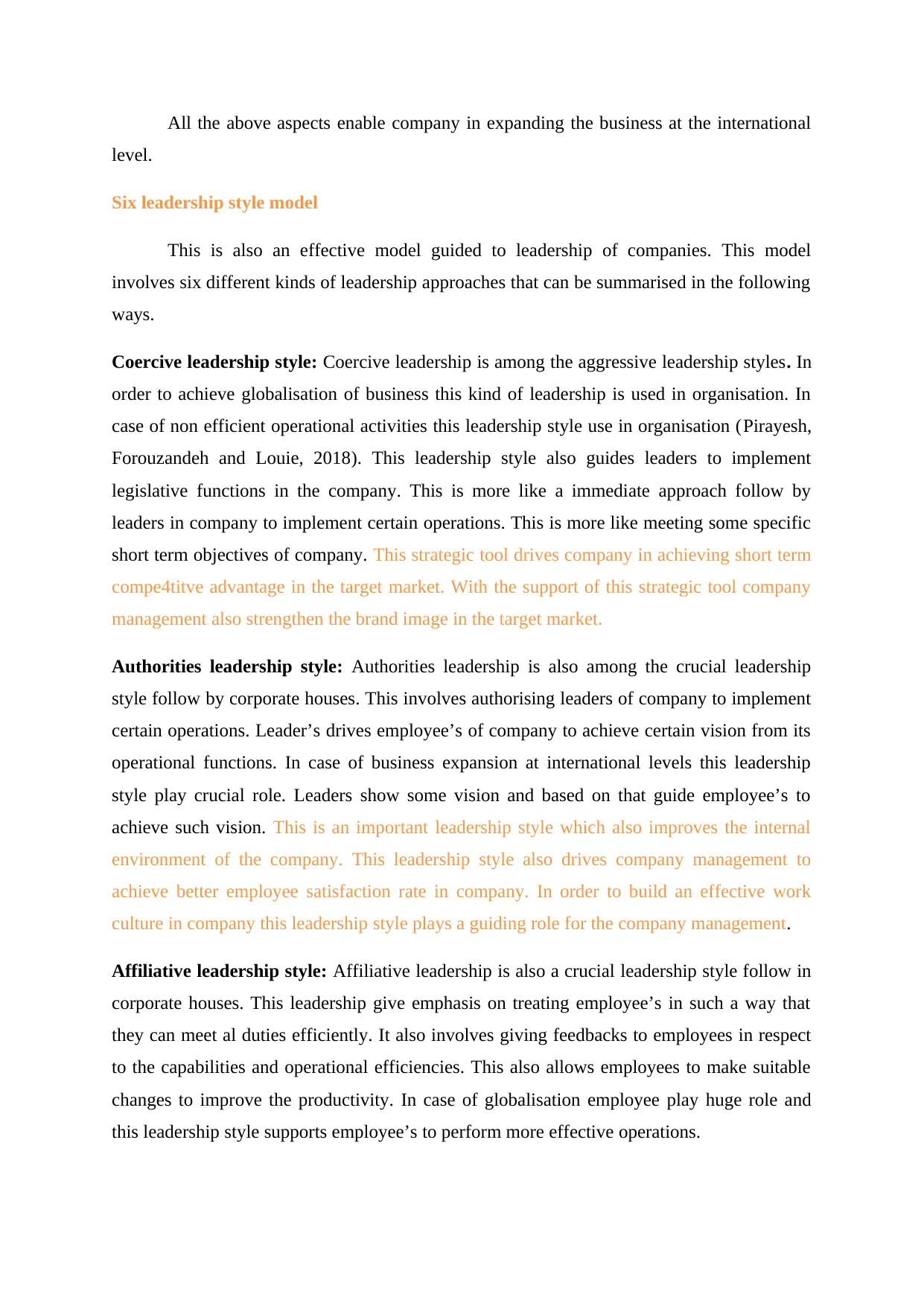
All the above aspects enable company in expanding the business at the international
level.
Six leadership style model
This is also an effective model guided to leadership of companies. This model
involves six different kinds of leadership approaches that can be summarised in the following
ways.
Coercive leadership style: Coercive leadership is among the aggressive leadership styles. In
order to achieve globalisation of business this kind of leadership is used in organisation. In
case of non efficient operational activities this leadership style use in organisation (Pirayesh,
Forouzandeh and Louie, 2018). This leadership style also guides leaders to implement
legislative functions in the company. This is more like a immediate approach follow by
leaders in company to implement certain operations. This is more like meeting some specific
short term objectives of company. This strategic tool drives company in achieving short term
compe4titve advantage in the target market. With the support of this strategic tool company
management also strengthen the brand image in the target market.
Authorities leadership style: Authorities leadership is also among the crucial leadership
style follow by corporate houses. This involves authorising leaders of company to implement
certain operations. Leader’s drives employee’s of company to achieve certain vision from its
operational functions. In case of business expansion at international levels this leadership
style play crucial role. Leaders show some vision and based on that guide employee’s to
achieve such vision. This is an important leadership style which also improves the internal
environment of the company. This leadership style also drives company management to
achieve better employee satisfaction rate in company. In order to build an effective work
culture in company this leadership style plays a guiding role for the company management.
Affiliative leadership style: Affiliative leadership is also a crucial leadership style follow in
corporate houses. This leadership give emphasis on treating employee’s in such a way that
they can meet al duties efficiently. It also involves giving feedbacks to employees in respect
to the capabilities and operational efficiencies. This also allows employees to make suitable
changes to improve the productivity. In case of globalisation employee play huge role and
this leadership style supports employee’s to perform more effective operations.
level.
Six leadership style model
This is also an effective model guided to leadership of companies. This model
involves six different kinds of leadership approaches that can be summarised in the following
ways.
Coercive leadership style: Coercive leadership is among the aggressive leadership styles. In
order to achieve globalisation of business this kind of leadership is used in organisation. In
case of non efficient operational activities this leadership style use in organisation (Pirayesh,
Forouzandeh and Louie, 2018). This leadership style also guides leaders to implement
legislative functions in the company. This is more like a immediate approach follow by
leaders in company to implement certain operations. This is more like meeting some specific
short term objectives of company. This strategic tool drives company in achieving short term
compe4titve advantage in the target market. With the support of this strategic tool company
management also strengthen the brand image in the target market.
Authorities leadership style: Authorities leadership is also among the crucial leadership
style follow by corporate houses. This involves authorising leaders of company to implement
certain operations. Leader’s drives employee’s of company to achieve certain vision from its
operational functions. In case of business expansion at international levels this leadership
style play crucial role. Leaders show some vision and based on that guide employee’s to
achieve such vision. This is an important leadership style which also improves the internal
environment of the company. This leadership style also drives company management to
achieve better employee satisfaction rate in company. In order to build an effective work
culture in company this leadership style plays a guiding role for the company management.
Affiliative leadership style: Affiliative leadership is also a crucial leadership style follow in
corporate houses. This leadership give emphasis on treating employee’s in such a way that
they can meet al duties efficiently. It also involves giving feedbacks to employees in respect
to the capabilities and operational efficiencies. This also allows employees to make suitable
changes to improve the productivity. In case of globalisation employee play huge role and
this leadership style supports employee’s to perform more effective operations.
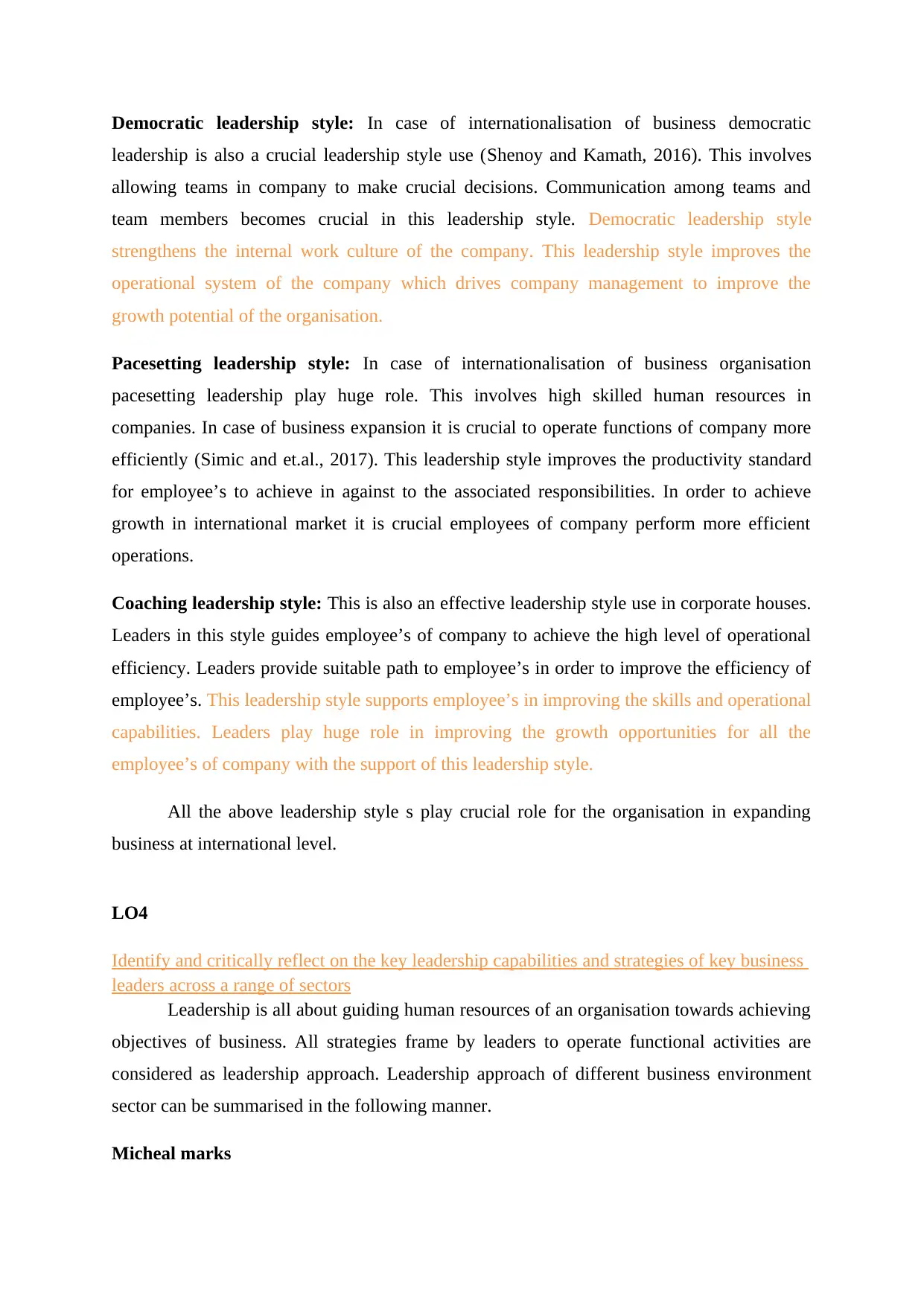
Democratic leadership style: In case of internationalisation of business democratic
leadership is also a crucial leadership style use (Shenoy and Kamath, 2016). This involves
allowing teams in company to make crucial decisions. Communication among teams and
team members becomes crucial in this leadership style. Democratic leadership style
strengthens the internal work culture of the company. This leadership style improves the
operational system of the company which drives company management to improve the
growth potential of the organisation.
Pacesetting leadership style: In case of internationalisation of business organisation
pacesetting leadership play huge role. This involves high skilled human resources in
companies. In case of business expansion it is crucial to operate functions of company more
efficiently (Simic and et.al., 2017). This leadership style improves the productivity standard
for employee’s to achieve in against to the associated responsibilities. In order to achieve
growth in international market it is crucial employees of company perform more efficient
operations.
Coaching leadership style: This is also an effective leadership style use in corporate houses.
Leaders in this style guides employee’s of company to achieve the high level of operational
efficiency. Leaders provide suitable path to employee’s in order to improve the efficiency of
employee’s. This leadership style supports employee’s in improving the skills and operational
capabilities. Leaders play huge role in improving the growth opportunities for all the
employee’s of company with the support of this leadership style.
All the above leadership style s play crucial role for the organisation in expanding
business at international level.
LO4
Identify and critically reflect on the key leadership capabilities and strategies of key business
leaders across a range of sectors
Leadership is all about guiding human resources of an organisation towards achieving
objectives of business. All strategies frame by leaders to operate functional activities are
considered as leadership approach. Leadership approach of different business environment
sector can be summarised in the following manner.
Micheal marks
leadership is also a crucial leadership style use (Shenoy and Kamath, 2016). This involves
allowing teams in company to make crucial decisions. Communication among teams and
team members becomes crucial in this leadership style. Democratic leadership style
strengthens the internal work culture of the company. This leadership style improves the
operational system of the company which drives company management to improve the
growth potential of the organisation.
Pacesetting leadership style: In case of internationalisation of business organisation
pacesetting leadership play huge role. This involves high skilled human resources in
companies. In case of business expansion it is crucial to operate functions of company more
efficiently (Simic and et.al., 2017). This leadership style improves the productivity standard
for employee’s to achieve in against to the associated responsibilities. In order to achieve
growth in international market it is crucial employees of company perform more efficient
operations.
Coaching leadership style: This is also an effective leadership style use in corporate houses.
Leaders in this style guides employee’s of company to achieve the high level of operational
efficiency. Leaders provide suitable path to employee’s in order to improve the efficiency of
employee’s. This leadership style supports employee’s in improving the skills and operational
capabilities. Leaders play huge role in improving the growth opportunities for all the
employee’s of company with the support of this leadership style.
All the above leadership style s play crucial role for the organisation in expanding
business at international level.
LO4
Identify and critically reflect on the key leadership capabilities and strategies of key business
leaders across a range of sectors
Leadership is all about guiding human resources of an organisation towards achieving
objectives of business. All strategies frame by leaders to operate functional activities are
considered as leadership approach. Leadership approach of different business environment
sector can be summarised in the following manner.
Micheal marks
⊘ This is a preview!⊘
Do you want full access?
Subscribe today to unlock all pages.

Trusted by 1+ million students worldwide
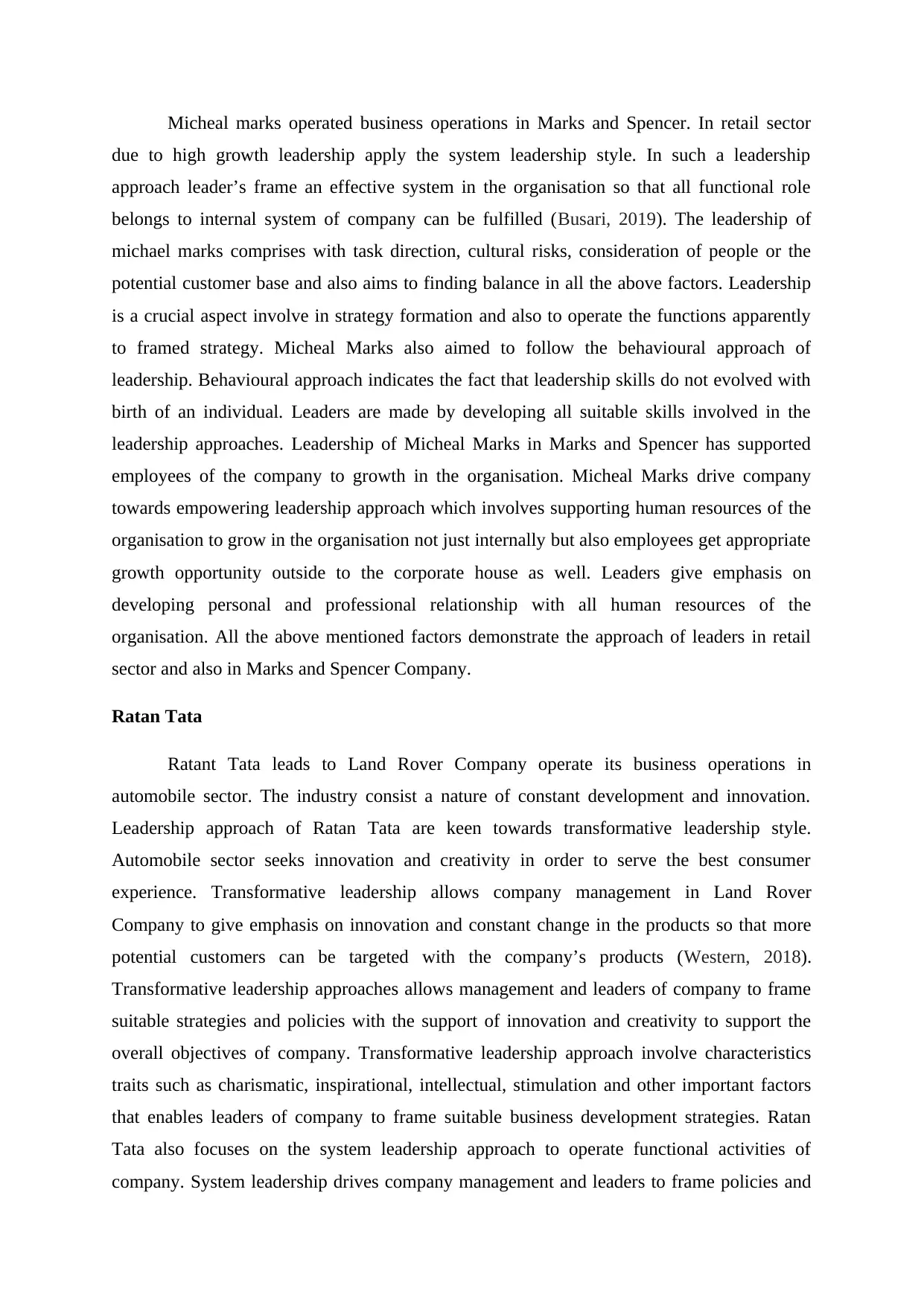
Micheal marks operated business operations in Marks and Spencer. In retail sector
due to high growth leadership apply the system leadership style. In such a leadership
approach leader’s frame an effective system in the organisation so that all functional role
belongs to internal system of company can be fulfilled (Busari, 2019). The leadership of
michael marks comprises with task direction, cultural risks, consideration of people or the
potential customer base and also aims to finding balance in all the above factors. Leadership
is a crucial aspect involve in strategy formation and also to operate the functions apparently
to framed strategy. Micheal Marks also aimed to follow the behavioural approach of
leadership. Behavioural approach indicates the fact that leadership skills do not evolved with
birth of an individual. Leaders are made by developing all suitable skills involved in the
leadership approaches. Leadership of Micheal Marks in Marks and Spencer has supported
employees of the company to growth in the organisation. Micheal Marks drive company
towards empowering leadership approach which involves supporting human resources of the
organisation to grow in the organisation not just internally but also employees get appropriate
growth opportunity outside to the corporate house as well. Leaders give emphasis on
developing personal and professional relationship with all human resources of the
organisation. All the above mentioned factors demonstrate the approach of leaders in retail
sector and also in Marks and Spencer Company.
Ratan Tata
Ratant Tata leads to Land Rover Company operate its business operations in
automobile sector. The industry consist a nature of constant development and innovation.
Leadership approach of Ratan Tata are keen towards transformative leadership style.
Automobile sector seeks innovation and creativity in order to serve the best consumer
experience. Transformative leadership allows company management in Land Rover
Company to give emphasis on innovation and constant change in the products so that more
potential customers can be targeted with the company’s products (Western, 2018).
Transformative leadership approaches allows management and leaders of company to frame
suitable strategies and policies with the support of innovation and creativity to support the
overall objectives of company. Transformative leadership approach involve characteristics
traits such as charismatic, inspirational, intellectual, stimulation and other important factors
that enables leaders of company to frame suitable business development strategies. Ratan
Tata also focuses on the system leadership approach to operate functional activities of
company. System leadership drives company management and leaders to frame policies and
due to high growth leadership apply the system leadership style. In such a leadership
approach leader’s frame an effective system in the organisation so that all functional role
belongs to internal system of company can be fulfilled (Busari, 2019). The leadership of
michael marks comprises with task direction, cultural risks, consideration of people or the
potential customer base and also aims to finding balance in all the above factors. Leadership
is a crucial aspect involve in strategy formation and also to operate the functions apparently
to framed strategy. Micheal Marks also aimed to follow the behavioural approach of
leadership. Behavioural approach indicates the fact that leadership skills do not evolved with
birth of an individual. Leaders are made by developing all suitable skills involved in the
leadership approaches. Leadership of Micheal Marks in Marks and Spencer has supported
employees of the company to growth in the organisation. Micheal Marks drive company
towards empowering leadership approach which involves supporting human resources of the
organisation to grow in the organisation not just internally but also employees get appropriate
growth opportunity outside to the corporate house as well. Leaders give emphasis on
developing personal and professional relationship with all human resources of the
organisation. All the above mentioned factors demonstrate the approach of leaders in retail
sector and also in Marks and Spencer Company.
Ratan Tata
Ratant Tata leads to Land Rover Company operate its business operations in
automobile sector. The industry consist a nature of constant development and innovation.
Leadership approach of Ratan Tata are keen towards transformative leadership style.
Automobile sector seeks innovation and creativity in order to serve the best consumer
experience. Transformative leadership allows company management in Land Rover
Company to give emphasis on innovation and constant change in the products so that more
potential customers can be targeted with the company’s products (Western, 2018).
Transformative leadership approaches allows management and leaders of company to frame
suitable strategies and policies with the support of innovation and creativity to support the
overall objectives of company. Transformative leadership approach involve characteristics
traits such as charismatic, inspirational, intellectual, stimulation and other important factors
that enables leaders of company to frame suitable business development strategies. Ratan
Tata also focuses on the system leadership approach to operate functional activities of
company. System leadership drives company management and leaders to frame policies and
Paraphrase This Document
Need a fresh take? Get an instant paraphrase of this document with our AI Paraphraser
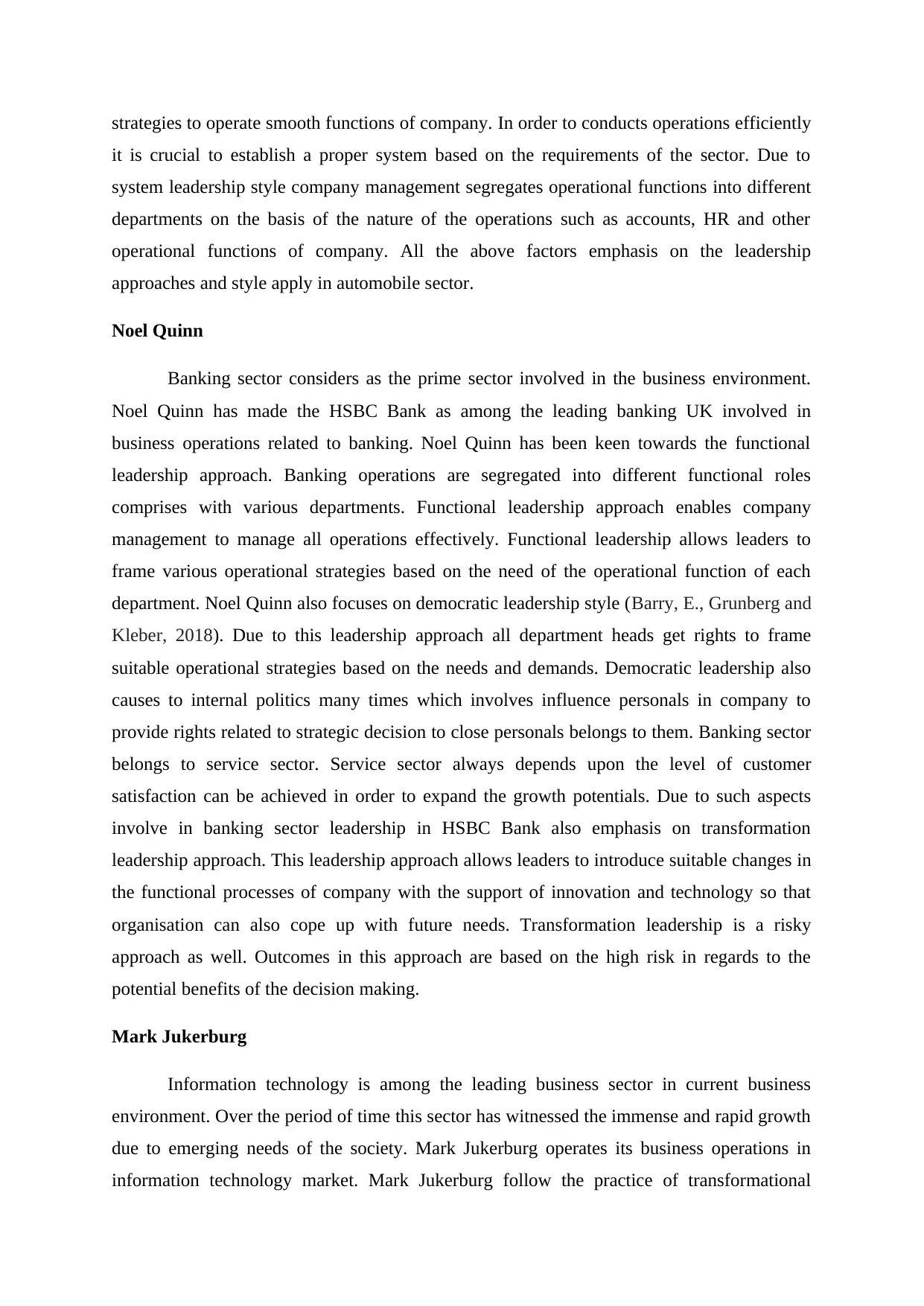
strategies to operate smooth functions of company. In order to conducts operations efficiently
it is crucial to establish a proper system based on the requirements of the sector. Due to
system leadership style company management segregates operational functions into different
departments on the basis of the nature of the operations such as accounts, HR and other
operational functions of company. All the above factors emphasis on the leadership
approaches and style apply in automobile sector.
Noel Quinn
Banking sector considers as the prime sector involved in the business environment.
Noel Quinn has made the HSBC Bank as among the leading banking UK involved in
business operations related to banking. Noel Quinn has been keen towards the functional
leadership approach. Banking operations are segregated into different functional roles
comprises with various departments. Functional leadership approach enables company
management to manage all operations effectively. Functional leadership allows leaders to
frame various operational strategies based on the need of the operational function of each
department. Noel Quinn also focuses on democratic leadership style (Barry, E., Grunberg and
Kleber, 2018). Due to this leadership approach all department heads get rights to frame
suitable operational strategies based on the needs and demands. Democratic leadership also
causes to internal politics many times which involves influence personals in company to
provide rights related to strategic decision to close personals belongs to them. Banking sector
belongs to service sector. Service sector always depends upon the level of customer
satisfaction can be achieved in order to expand the growth potentials. Due to such aspects
involve in banking sector leadership in HSBC Bank also emphasis on transformation
leadership approach. This leadership approach allows leaders to introduce suitable changes in
the functional processes of company with the support of innovation and technology so that
organisation can also cope up with future needs. Transformation leadership is a risky
approach as well. Outcomes in this approach are based on the high risk in regards to the
potential benefits of the decision making.
Mark Jukerburg
Information technology is among the leading business sector in current business
environment. Over the period of time this sector has witnessed the immense and rapid growth
due to emerging needs of the society. Mark Jukerburg operates its business operations in
information technology market. Mark Jukerburg follow the practice of transformational
it is crucial to establish a proper system based on the requirements of the sector. Due to
system leadership style company management segregates operational functions into different
departments on the basis of the nature of the operations such as accounts, HR and other
operational functions of company. All the above factors emphasis on the leadership
approaches and style apply in automobile sector.
Noel Quinn
Banking sector considers as the prime sector involved in the business environment.
Noel Quinn has made the HSBC Bank as among the leading banking UK involved in
business operations related to banking. Noel Quinn has been keen towards the functional
leadership approach. Banking operations are segregated into different functional roles
comprises with various departments. Functional leadership approach enables company
management to manage all operations effectively. Functional leadership allows leaders to
frame various operational strategies based on the need of the operational function of each
department. Noel Quinn also focuses on democratic leadership style (Barry, E., Grunberg and
Kleber, 2018). Due to this leadership approach all department heads get rights to frame
suitable operational strategies based on the needs and demands. Democratic leadership also
causes to internal politics many times which involves influence personals in company to
provide rights related to strategic decision to close personals belongs to them. Banking sector
belongs to service sector. Service sector always depends upon the level of customer
satisfaction can be achieved in order to expand the growth potentials. Due to such aspects
involve in banking sector leadership in HSBC Bank also emphasis on transformation
leadership approach. This leadership approach allows leaders to introduce suitable changes in
the functional processes of company with the support of innovation and technology so that
organisation can also cope up with future needs. Transformation leadership is a risky
approach as well. Outcomes in this approach are based on the high risk in regards to the
potential benefits of the decision making.
Mark Jukerburg
Information technology is among the leading business sector in current business
environment. Over the period of time this sector has witnessed the immense and rapid growth
due to emerging needs of the society. Mark Jukerburg operates its business operations in
information technology market. Mark Jukerburg follow the practice of transformational
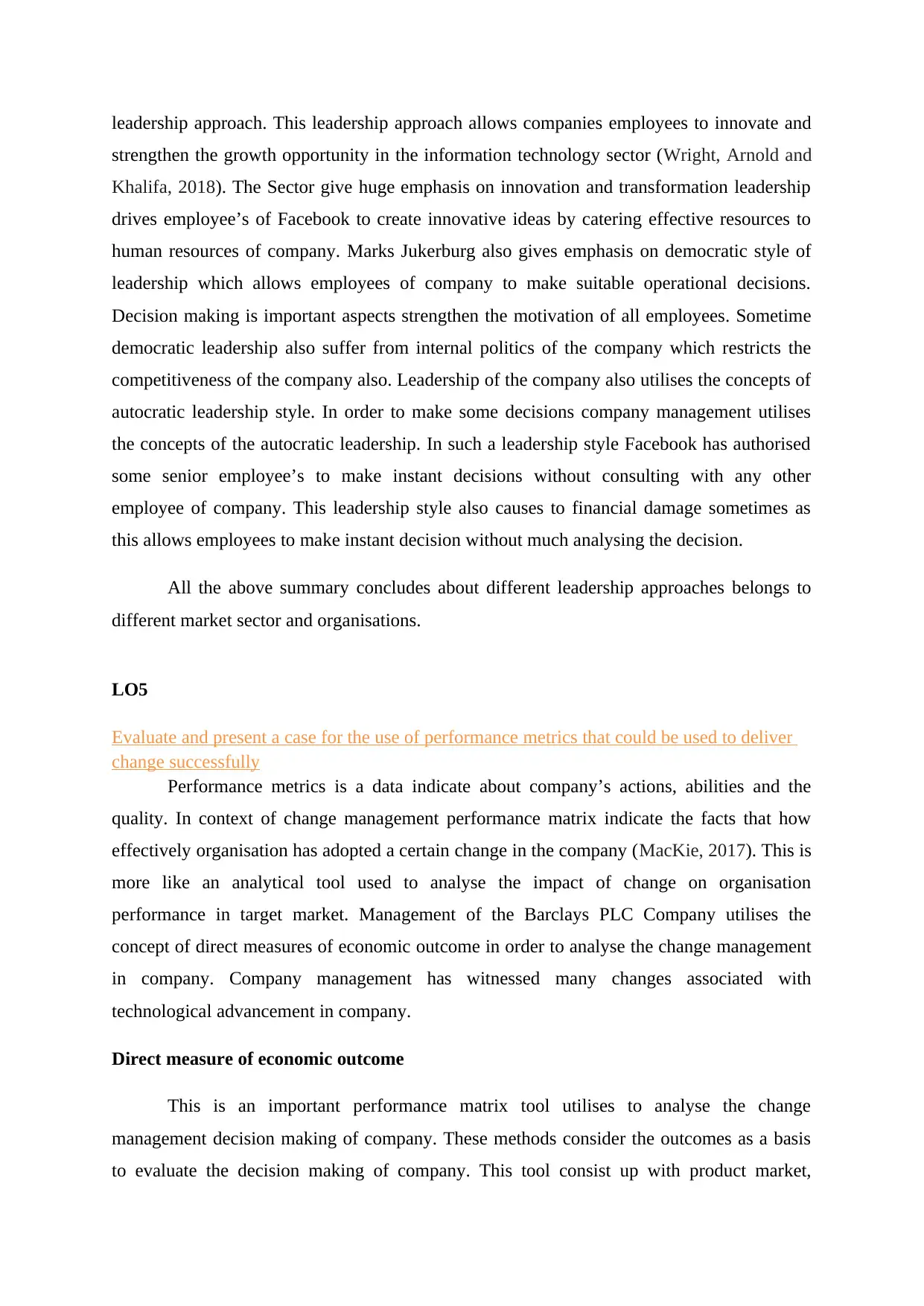
leadership approach. This leadership approach allows companies employees to innovate and
strengthen the growth opportunity in the information technology sector (Wright, Arnold and
Khalifa, 2018). The Sector give huge emphasis on innovation and transformation leadership
drives employee’s of Facebook to create innovative ideas by catering effective resources to
human resources of company. Marks Jukerburg also gives emphasis on democratic style of
leadership which allows employees of company to make suitable operational decisions.
Decision making is important aspects strengthen the motivation of all employees. Sometime
democratic leadership also suffer from internal politics of the company which restricts the
competitiveness of the company also. Leadership of the company also utilises the concepts of
autocratic leadership style. In order to make some decisions company management utilises
the concepts of the autocratic leadership. In such a leadership style Facebook has authorised
some senior employee’s to make instant decisions without consulting with any other
employee of company. This leadership style also causes to financial damage sometimes as
this allows employees to make instant decision without much analysing the decision.
All the above summary concludes about different leadership approaches belongs to
different market sector and organisations.
LO5
Evaluate and present a case for the use of performance metrics that could be used to deliver
change successfully
Performance metrics is a data indicate about company’s actions, abilities and the
quality. In context of change management performance matrix indicate the facts that how
effectively organisation has adopted a certain change in the company (MacKie, 2017). This is
more like an analytical tool used to analyse the impact of change on organisation
performance in target market. Management of the Barclays PLC Company utilises the
concept of direct measures of economic outcome in order to analyse the change management
in company. Company management has witnessed many changes associated with
technological advancement in company.
Direct measure of economic outcome
This is an important performance matrix tool utilises to analyse the change
management decision making of company. These methods consider the outcomes as a basis
to evaluate the decision making of company. This tool consist up with product market,
strengthen the growth opportunity in the information technology sector (Wright, Arnold and
Khalifa, 2018). The Sector give huge emphasis on innovation and transformation leadership
drives employee’s of Facebook to create innovative ideas by catering effective resources to
human resources of company. Marks Jukerburg also gives emphasis on democratic style of
leadership which allows employees of company to make suitable operational decisions.
Decision making is important aspects strengthen the motivation of all employees. Sometime
democratic leadership also suffer from internal politics of the company which restricts the
competitiveness of the company also. Leadership of the company also utilises the concepts of
autocratic leadership style. In order to make some decisions company management utilises
the concepts of the autocratic leadership. In such a leadership style Facebook has authorised
some senior employee’s to make instant decisions without consulting with any other
employee of company. This leadership style also causes to financial damage sometimes as
this allows employees to make instant decision without much analysing the decision.
All the above summary concludes about different leadership approaches belongs to
different market sector and organisations.
LO5
Evaluate and present a case for the use of performance metrics that could be used to deliver
change successfully
Performance metrics is a data indicate about company’s actions, abilities and the
quality. In context of change management performance matrix indicate the facts that how
effectively organisation has adopted a certain change in the company (MacKie, 2017). This is
more like an analytical tool used to analyse the impact of change on organisation
performance in target market. Management of the Barclays PLC Company utilises the
concept of direct measures of economic outcome in order to analyse the change management
in company. Company management has witnessed many changes associated with
technological advancement in company.
Direct measure of economic outcome
This is an important performance matrix tool utilises to analyse the change
management decision making of company. These methods consider the outcomes as a basis
to evaluate the decision making of company. This tool consist up with product market,
⊘ This is a preview!⊘
Do you want full access?
Subscribe today to unlock all pages.

Trusted by 1+ million students worldwide
1 out of 16
Related Documents
Your All-in-One AI-Powered Toolkit for Academic Success.
+13062052269
info@desklib.com
Available 24*7 on WhatsApp / Email
![[object Object]](/_next/static/media/star-bottom.7253800d.svg)
Unlock your academic potential
Copyright © 2020–2025 A2Z Services. All Rights Reserved. Developed and managed by ZUCOL.


